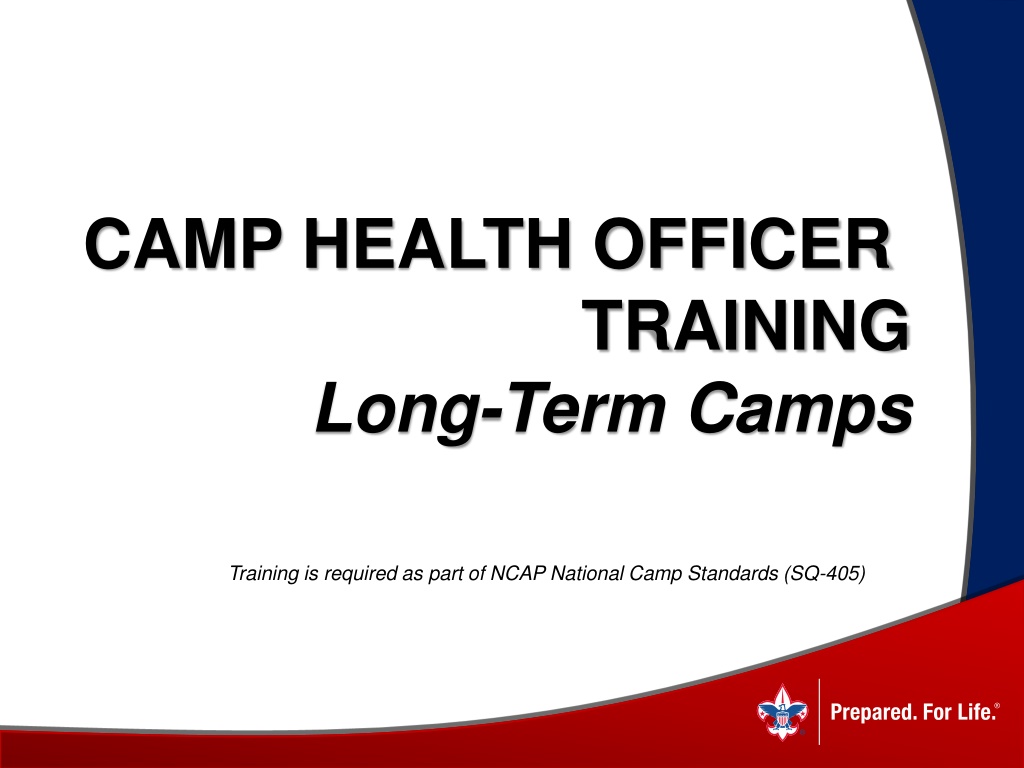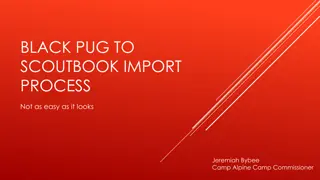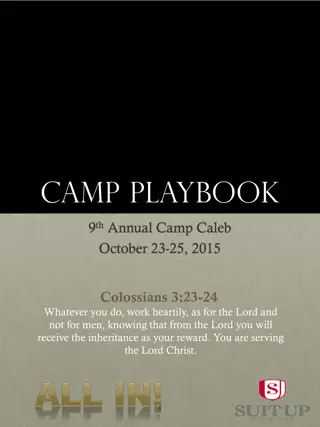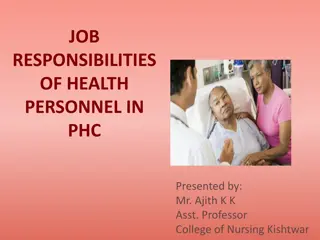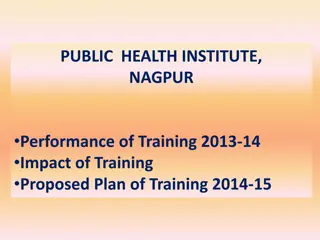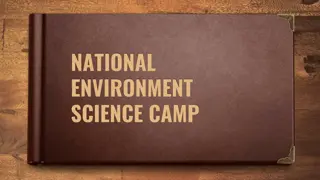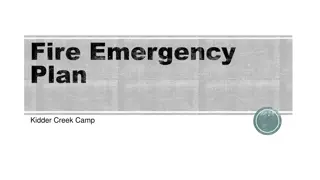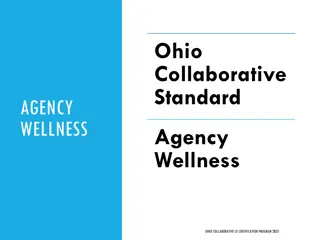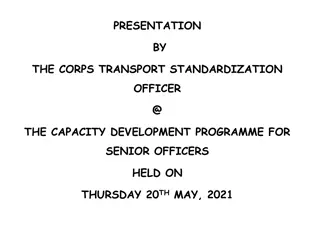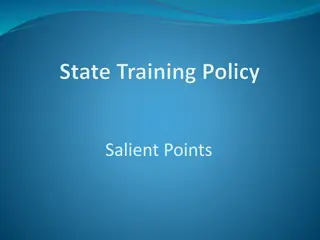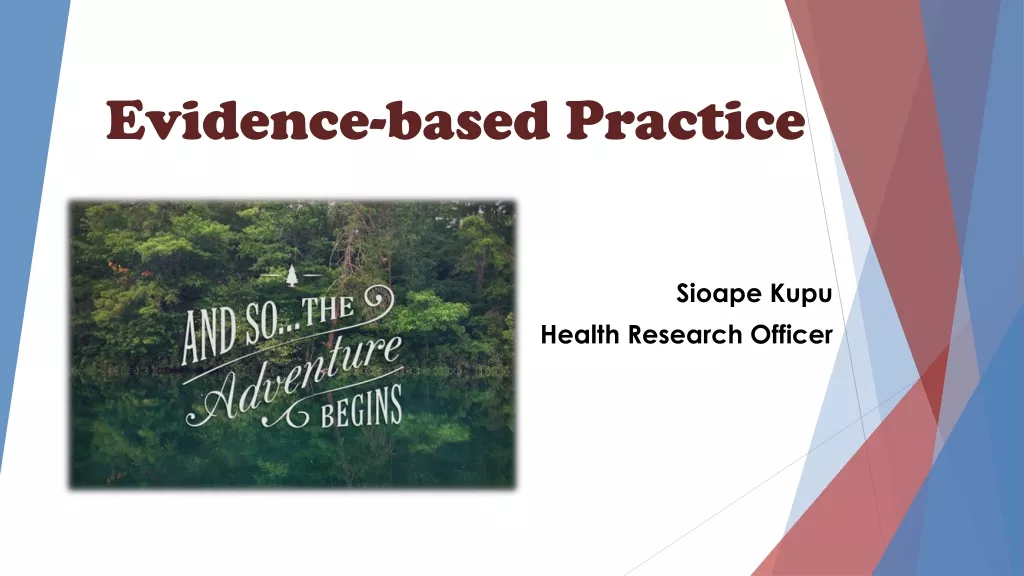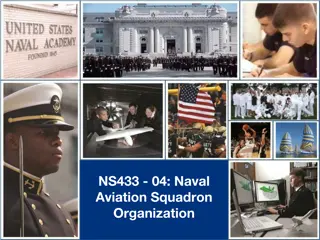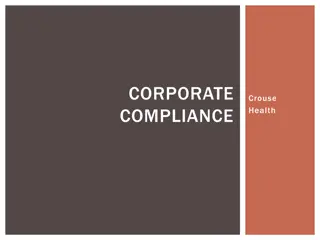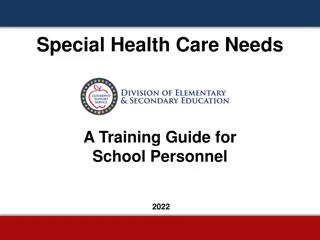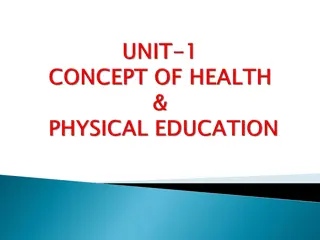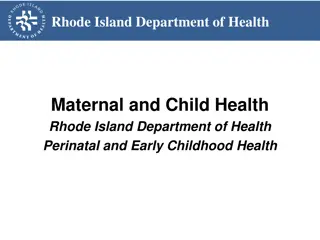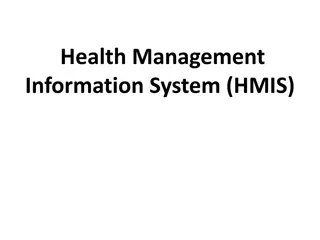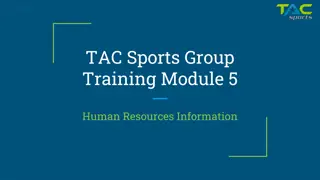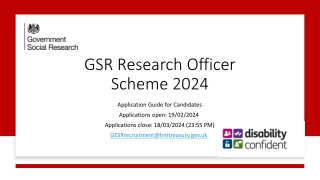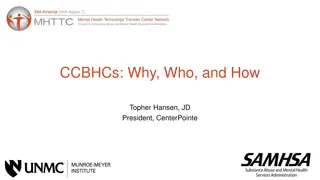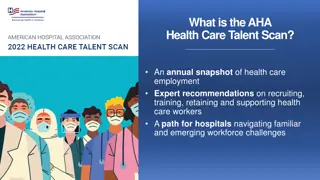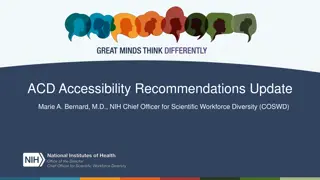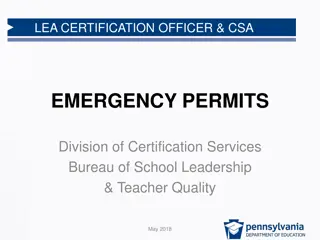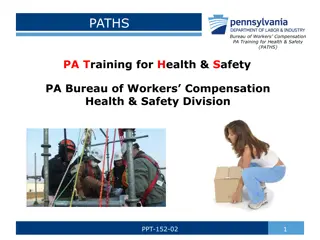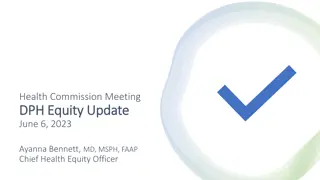Camp Health Officer Training Overview
Camp Health Officer Training is a crucial requirement for long-term camps to adhere to NCAP National Camp Standards. This training covers the roles, responsibilities, and duties of the Camp Health Officer (CHO) before, during, and after camp. Participants will learn about managing the health lodge, recording and reporting injuries and illnesses, and working with key personnel such as the Council Health Supervisor and Camp Director. The training aims to ensure safe and high-quality camping experiences.
Download Presentation

Please find below an Image/Link to download the presentation.
The content on the website is provided AS IS for your information and personal use only. It may not be sold, licensed, or shared on other websites without obtaining consent from the author. Download presentation by click this link. If you encounter any issues during the download, it is possible that the publisher has removed the file from their server.
E N D
Presentation Transcript
CAMP HEALTH OFFICER TRAINING Long-Term Camps Training is required as part of NCAP National Camp Standards (SQ-405) Revised Nov 2020
Outline Outline Introduction to this Training Who you will work with as the Camp Health Officer (CHO) Overview of your role Qualifications, duties and expectations Managing the health lodge Duties before camp Duties during camp Duties when closing camp Quiz 2
Introduction: Introduction: Why take this training? National Camp Accreditation Program s National Camp Standards, (BSA No. 430-056) guide camps in their participation in the National Camp Accreditation Program (NCAP) conducted by the Boy Scouts of America. NCAP Standard SQ-405 requires you to take this CHO training. These standards have a number of critical policies and procedures that direct your work and that of all those involved in Scout camping. They are in place to provide safe and quality programing. 3
Introduction: Introduction: What you will learn This training course will introduce you to the camp environment and to your role as the Camp Health Officer one of the most critical roles in camp. This course will help you understand some of the important steps in providing adequate health and safety in the camp environment. 4
Objectives of Objectives of Camp Health Officer Training Camp Health Officer Training At the end of this training course, you should: Understand the duties and responsibilities of the camp health officer before, during, and after camp. Be able to implement the policies, procedures, and reference materials you need to do your job. Understand the requirements for recording and reporting injuries and illness, which are also part of your job. 5
Who you will work with as the Who you will work with as the Camp Health Officer Camp Health Officer Council Health Supervisor Camp Director Camp Staff Council Enterprise Risk Management Committee 6
Council Health Supervisor Council Health Supervisor (CHS) Medical care and health supervision at the camp is under the direction of the Council Health Supervisor (CHS). The CHS is a physician licensed in the state where the camp is located. Refer to NCAP Standard SQ-405. How the CHS helps the Camp Health Officer: The CHS is available to support the needs or concerns of the Camp Health Officer throughout the camp season. He or she will work with the CHO to train camp staff on any policies and procedures for the camp. The CHS provides written instruction (standing orders) for the Camp Health Officer to follow. See NCAP Standard HS-505. The CHS will have approved all policies, procedures, and supply/equipment lists before camp opens. 7
Camp Director Camp Director Like the CHS, the Camp Director will be available to support the needs or concerns of the Camp Health Officer throughout the camp season. He or she will work with the CHO to train camp staff on any policies and procedures for the camp. Camp Staff Camp Staff Camp staff are your coworkers But you are ultimately responsible for tracking their health and safety (such as with pre-camp medical screening), following OSHA guidelines, and encouraging them to assist with maintaining overall camp health and safety How the Camp Director and Camp Staff help the Camp Health Officer Everyone is responsible for camp health and safety! 8
Council Enterprise Risk Council Enterprise Risk Management Committee Management Committee The Council Enterprise Risk Management committee (ERM) works with council staff to provide guidance, oversight, policy, and procedures for the operation of the camp health lodge. How the ERM helps the Camp Health Officer: The ERM committee is a vital resource for the Camp Health Officer and may be called upon for assistance. 9
Overview: Overview: Qualifications of the Camp Health Officer (CHO) All medical care is under the direction of the Council Health Supervisor. At the minimum, the CHO must be CPR and AED certified from a nationally recognized provider, have completed this Camp Health Officer s Training course, be at least 18 years of age, lives on-site, is on the camp property, and is on call at all times. Refer to NCAP Standard SQ-405. The CHO scope of practice depends on their qualifications (EMT, RN, MD, etc.). These qualifications must be appropriate for the nature of the camp and its proximity to an emergency medical system (EMS). When access to EMS is less than 10 minutes, the CHO must be certified in American Red Cross Standard First Aid and CPR/AED for Professional Rescuers and Health Care Providers, or equivalents from a nationally recognized provider. When access to EMS is greater than 10 minutes, the CHO must be licensed as a physician, nurse practitioner, Nurse (RN, LPN, or LVN), physician assistant, paramedic, emergency medical technician (basic, intermediate, or paramedic), licensed or registered emergency medical responder. Nurse s aides, Certified Nursing Assistants (CNAs), and assistants do not qualify. When access to EMS is greater than 60 minutes, the Camp Health Officer must also have current certification in American Red Cross Wilderness and Remote First Aid, or equivalent. 10
Overview: Overview: Preparing to serve as the Camp Health Officer This training is the first step to being prepared as a CHO. At the end of this training, review the items on the resource lists at the end of this presentation, including the National Camp Standards. Attend camp staff orientation and training. Review policies, procedures, and other documents or checklists that have been developed for the camp health lodge. Review the standing orders (signed by the Council Health Supervisor) prior to the start of camp. Refer to NCAP Standard HS-505 and HS-506. 11
Overview: Overview: Duties and Expectations You have an important role in the health and safety of the camp. This role has a number of critical responsibilities: As the CHO, your overarching focus must be on the prevention of injuries and the promotion of health and safety. You need to ensure that all the camp staff are ready to respond to an emergency. On a day-to-day basis, you need to: address the routine medical needs of everyone in camp, maintain the health lodge, and maintain the first aid, health and medication logs. 12
Duties and Expectations, cont. One of your most important duties will be to ensure that your team other camp staff is ready to respond to an emergency. During pre-camp staff training, pay close attention to the safety elements of each area leader s role and to situations that affect the welfare of the camp. Encourage every staff member to model health and safety practices to the youth and adult leaders at camp. You should be prepared to support them in these activities. General camp safety practices are a concern of all staff members, and you are key to the team that will identify risks, provide health education, and respond to emergencies. 13
Duties and Expectations, cont. Depending on state laws and your qualifications, below are some activities that may be part of completing these duties. Camp health operations include scope of care; procedures for the health lodge/first-aid station; operating practices (such as hours of service, emergency care, standard orders, and provision of first-aid kits, AEDs, etc.) Camp treatment procedures (standing orders) should delineate what is treated at camp and how, when EMS should be used, and procedures for any emergency medications and equipment that may be used by qualified staff. EMS services procedures for calling, contact information, and providing orientation to the EMS services providing service to the camp. Equipment and supplies needed for camp including verifying expiration dates, discarding expired medications and supplies, maintaining medications at camp, and maintaining AEDs. Health screening for participants and staff. Medication management including administering, storing, and securing them. Sanitation of health facilities with procedures for dealing with contaminated waste and sharps. Selection and maintenance of camp first-aid kits. 14
Duties and Expectations, cont. Maintain daily records of all first-aid and medical treatments (written in ink) kept in the First Aid Logbooks, maintained separately for campers and for staff members. Review the First Aid Log with the Camp Director at least weekly, to determine trends to be analyzed and any corrective actions to be taken. All injuries, illnesses, and incidents beyond basic Scout-rendered first aid are reported promptly following BSA incident reporting requirements. The Camp Health Officer should immediately inform the Camp Director of all such occurances. The CHS should also be notified as soon as possible. In the event of a fatality, communicable disease outbreak, or other serious incidents the Scout Executive must report the event as soon as reasonably possible. Protocols are outlined in NCAP Standard AO- 808. In the event of a fatality or catastrophic injury or illness, the Camp Director is generally the incident commander with the Camp Health Officer providing emergent care until help arrives. At the close of camp, all First Aid Logs are submitted to the council for record keeping; and incident reports are made available to the Enterprise Risk Management committee for review. 15
Duties: Duties: Managing the Health Lodge Depending on the camp, you may be responsible for the management of the camp s health lodge. Typical expectations for managing a camp health lodge are on the following slides. Because every camp is unique, be sure to discuss with the CHS what your responsibilities for the health lodge will be. 16
Managing the Health Lodge, cont. If you are responsible for the management of the health lodge, this will be one of your most important duties. The purpose of the camp health lodge is to provide a comfortable, quiet, private, and properly equipped place to give temporary care to ill or injured campers. The health lodge should be located conveniently near the central part of camp but far enough away from other facilities to provide privacy. It should be located so that transport from a remote area or transport by EMS out of camp is possible. A health lodge with good signage that is conveniently located helps encourage campers and others to report promptly for first-aid treatment. Refer to NCAP Standard HS-509. 17
Managing the Health Lodge, cont. The health lodge should be neat and clean and as attractive as camping conditions will permit. The surroundings should be pleasant for those who are in the health lodge. A clean, pleasant-smelling health lodge is important. Depending on the facilities available, you will have a waiting area, private restrooms, lodging for the camp health officer, overnight accommodations for the ill or injured, dedicated refrigerator for only storing medications, or other facilities provided by the council. In small camps, the health lodge may be only a good tent with a canopy. Refer to NCAP Standard HS-509. Whatever the physical arrangements, your job is to provide the best of care within those facilities. 18
Managing the Health Lodge, cont. The health lodge should consist of several rooms, if possible. The wardroom should include at least two hospital-type beds or cots, a bedside table, a chair, and adequate light. Windows should be screened and provide cross- ventilation. If your council or camp uses a tent for the health lodge, it should have a floor and adequate protection against insects and the sun. Clean beds should be ready for use at all times, with mattresses, and clean pillows, linens and blankets in place. Youth protection requirements must be followed. If overnight care is anticipated, 2 deep observation, toileting, food and laundry must be provided. 19
Managing the Health Lodge, cont. The equipment and supplies found in your camp health lodge should be approved by the Council ERM and the Council Health Supervisor based on their experience and feedback from prior camp health officers. Your feedback at the end of the camping season will help guide them to make improvements based on your experiences. The camp shall provide a clearly marked health care area that is appropriately equipped and includes an automated external defibrillator (for all camps); lockable medical storage system (dry and cold); available toilets, washing water, and drinking water; space for medical treatment; and protection from outside elements. Refer to NCAP Standard HS-509. 20
Managing the Health Lodge, cont. Do not bring or leave unauthorized supplies, medications, and equipment or allow others to do so. Well-intentioned donated supplies or equipment may encourage and support a level of care inappropriate for future camp health officers or others. As you arrive and begin opening the health lodge, familiarize yourself with the equipment provided and examine it often to ensure it remains in working condition. 21
Preparing for the Opening of Camp Preparing for the Opening of Camp Now that you ve read about the duties and expectations of the CHO, it s time to get ready for your service in camp. Your personal preparation will be key to being prepared for what you may be asked to do beginning your first day in camp. 22
Before Camp Opens Before Camp Opens Take a tour of the camp and be sure you can find your way around even in the dark. Begin your surveillance before campers are present. Issue or update (such as checking for expired medications) any first-aid kits that are in camp. Be sure to check with the area directors for the kits needed at their sites and check with the camp ranger to update the kit typically carried in his or her vehicle. Refer to NCAP Standard HS-510. Assess camp-wide first aid kits for their correct location, inventorying contents and ordering necessary replacements. Place (or verify the location of) the camp s AEDs and ensure that they are working and complete (e.g., unexpired pads and batteries). At least one AED is required at every long- term camp. Refer to NCAP Standard HS-509. 23
Before Camp Opens, cont. You will have much to do related to opening the camp health lodge. Some key steps include: Organizing and setting up the health lodge Inventorying health lodge supplies and, if necessary, ordering replacements Cleaning the health lodge inside and around the grounds Ensuring that all forms, policy manuals, phone lists, and other resource materials are in place and current. Using existing resources, review and implement the camp s written plan on bloodborne pathogens and be prepared to train staff members. Refer to NCAP Standard AO-805. Know and be able to implement the camp s written emergency procedures (described next). Refer to NCAP Standard AO-805. 24
Before Camp Opens, cont. Your camp has emergency action plans specific to the camp and the hazards that have been identified. Emergency action plans include detailed instructions for dealing with fires, serious illnesses, accidents, and fatalities. Refer to NCAP Standard AO-805. You are an important part of these plans. Before the opening of camp season, review the plan and understand your role as the Camp Health Officer so that you can move quickly when faced with an emergency situation. Review common health and safety risks in the outdoors (e.g. animal and insect bites or stings, contact with poisonous plants, heat/cold, dehydration, trauma injuries, or aquatics hazards) 25
Before Camp Opens, cont. You should review the camp plan on how to respond to situations including: Evacuation of possible back or neck injuries Serious illnesses Fatalities Camp crises such as active shooters, food poisoning, fire, flood, windstorm, search for a lost person, and outbreak of an apparent contagious disease This plan and your planned response should be known and maintained in the camp health lodge and included in your policies and procedures. Share your suggestions for change or implementation of the emergency action plan with the Camp Director. 26
Before Camp Opens, cont. Check with the Camp Director to ensure that contact has been made with off-camp referral agencies such as the local nonresident camp physician, council heath supervisor, referral emergency rooms, local ambulance service, paramedics or EMTs, and local police and fire departments. Work with local hospitals and ambulance services for the care and treatment of patients, including their rules and who the backups will be if they are unable to provide service. Identify a landing zone for Medevac extraction and the landing coordinates to communicate to them. 27
Before Camp Opens, cont. Verify the emergency phone list including the Scout Executive, Camp Director, and Council Health Supervisor. Refer to NCAP Standard AO-807. As a minimum, the list should include the following: Firefighters Police (state, county, and local) Hospital (Specify which local hospital is preferred by the council.) Emergency medical services (rescue squads and ambulances) Physicians (More than one listing is advised.) Mental Health Professionals 28
Before Camp Opens: Before Camp Opens: Understand How to Manage Medication Use The BSA s guiding principles for the safe use of medications include (Refer to NCAP Standards HS-504-508): All medications are the responsibility of either the individual taking the medication or that individual s parent or guardian. An adult leader, after obtaining all the necessary information and permission, can agree to accept the responsibility of making sure a youth takes the necessary medication at the appropriate time, but the BSA does not mandate or necessarily encourage the leader to do so. Your camp may have their own standards and policies regarding the administration of medications. State or local laws that are more limiting than camp policies supersede any BSA guidance and must be followed. 29
Managing Medication Use, cont. All prescription and nonprescription medications kept in the health lodge (including those needing refrigeration) must be stored in accordance with the state laws applicable to your camp location. Refer to NCAP Standard HS-508. The health lodge should have provisions for lockable storage, including refrigerated medications. Prescription medications stored outside the health lodge with the unit leader or other adult must be stored either under lock and key at the unit s site or under direct observation by the adult. The only exception is for a limited amount of medication for life-threatening conditions, such as epinephrine auto- injectors, heart medications and inhalers. These may be carried by a youth or adult member for personal use. 30
Managing Medication Use, cont. Read and understand the camp s policies and procedures for medication management. The First Aid Log includes a sample form (a routine drug administration record) you can use and issue to adult leaders to record prescription drug usage at camp. The procedures for medication management in camp should be reviewed with the adult leaders in camp during leader orientation. 31
Before Camp Opens Before Camp Opens, cont. Depending on the Camp Director s instructions, you may have additional responsibilities. These may also include: Participating in camp staff training Completing OSHA requirements Leading or taking CPR training Be sure to discuss with the Camp Director what your additional responsibilities will be. 32
Before Camp Opens: Before Camp Opens: Duties during Staff Week You may have a role in delivering pre-camp staff training. What you may teach will be specified by the Camp Director but will generally include: Information on the importance of operating the camp so that the number of accidents and illnesses is minimal and that positive mental health practices are promoted. Risk assessment and prevention is essential. General operating rules of the health lodge (hours, how and when first aid should be rendered at the site of injury vs. having it performed in the health lodge, etc.). Remember: health and safety takes a team effort! 33
Staff Week, cont. You will conduct a medical screening for each staff member. Refer to NCAP Standard HS-504. Identify and train selected staff members to assist in the staff medical screening process as needed. Know who else in camp has knowledge or skills that may be needed in an emergency (You can determine this during the medical screenings of staff). If you are teaching first aid or other classes, talk with the program director to determine what you need to do and prepare according to his or her instruction. 34
Staff Week, cont. If you are qualified, you may be called upon to educate staff in CPR, first aid, contents of first-aid kits, locations of AEDs, etc. If you are qualified, you may be asked to deliver bloodborne pathogen training that focuses on the use of personal protective equipment and supplies (gloves, sunscreen, eye protection, etc.). Refer to NCAP Standard HS-510. Make sure you are aware of any OSHA regulations that are relevant to the camp staff. Refer to NCAP Standard FA-703 and FA-713. Check with the Camp Director to see if you have other responsibilities 35
Duties During Camp Duties During Camp Now that you ve prepared for camp, it s time to deliver the best camping experience possible. Camp will be busy and you will find your days filled with a number of specific tasks and opportunities to create a safe and healthy experience for the Scouts, Scouters and Staff in camp. Your day-to-day activities and duties will include those tasks discussed on the next few slides. 36
During Camp: During Camp: Overview During the camp season, your duties may include any and probably all of the following: Conduct medical screenings, esp. as staff and campers arrive. Refer to NCAP Standard HS-504. Set up a medication dispensing plan. Refer to NCAP Standard HS-508. Meet with the Camp Director and adult leaders in camp Dispense medications daily and maintain records Treat in-camp injuries and illness. Refer to NCAP Standard HS-506. Check refrigerators where food is stored for proper temperature. Refer to NCAP Standard FA-709. Check latrines for proper cleanliness.Refer to NCAP Standard FA-707. 37
During Camp: During Camp: Screening At the beginning of each camping session, the Camp Health Officer and/or designated assistants (as needed) must provide a medical screening for each participant youth, adult, and staff member. Refer to NCAP Standard HS- 504. The screening must follow the established medical screening checklist provided by the Council Health Supervisor. The screening may vary by location and type of experience but will generally seek to identify whether the individual is healthy enough to participate in camp activities and how his or her health needs may alter either their ability to participate or require some special attention by leaders or camp staff. 38
Screening, cont. Screening also serves to identify any health condition that is present on arrival that may affect others (e.g., communicable diseases, rashes) and to provide a general health status (e.g., feeling and looking well). The camp health officer is responsible for seeing that those performing the medical screening have been trained in the process and in obtaining pertinent information and that the screening is conducted privately. Be careful to assure that Youth Protection guidelines are followed during screening. The confidentiality of the health information of each camper and staff member is protected. At the conclusion of the screening, the CHO (you) takes possession of the participant s Annual Health and Medical Record and maintains them according to established policies. Refer to NCAP Standard HS-503. 39
Screening, cont. The camp health officer may need to call upon the unit leader or other adult familiar with the individual participants to identify special health needs, medical considerations, or limitations of activities. Designated adult leaders should be identified at the screening process and should make available to you a current Annual Health and Medical Record for everyone in his or her unit. He or she can be called upon to assist in ensuring you have them and that they are as correct and complete as possible. The screening process is an ideal time to identify other medical resources who are in camp for the camping period and to obtain their agreement to contact (for example, a camper who is an RN). 40
During Camp: During Camp: Informing After screening, the Camp Director must be informed about campers with limitations or restrictions so that the appropriate staff members can be alerted. This information is shared only with the camp staff members who need to know, and they are instructed to handle this important information in a discreet and proper manner. 41
During Camp: During Camp: Deliver Care Open the health lodge and deliver care. Identify those who need care beyond what can be provided at camp and arrange for transportation and off-site treatment. All care must be within the scope of practice for someone with your qualifications and credentials (e.g., EMT, RN, MD, etc.) All care must be within the scope of the written council/camp medical care policies and procedures. (These policies should be reviewed by the CHS and ERM annually.) Refer to NCAP Standard HS- 506. 42
During Camp: During Camp: Deliver Care Other related responsibilities include: Maintaining the First Aid Log by entering all treatments. Refer to NCAP Standard HS-507. Maintaining the system for using and protecting the health records that allows for easy access and privacy. Refer to NCAP Standard HS-507. Assisting campers who have stored their medication at the health lodge. 43
During Camp: During Camp: Review and Analyze On an ongoing and constant basis, review the First Aid Log for trends. Immediately notify the Camp Director if issues such as outbreaks of illness or repeated injuries in an area are identified. Depending on the issue, you may need to notify others, such as the Council Health Supervisor or the local health department. On a weekly basis (or more frequently if needed), review the camp First Aid Log in depth and discuss it with the Camp Director. Refer to NCAP Standard HS-507. This review should include an analysis of incidents and accidents to determine if any special attention, program changes, or training is needed. Share this analysis on request with the rest of the staff. Be sure to maintain camper and staff confidentiality when discussing incidents or accidents. Ensure that corrective action items are established as a result of this review. Have the Camp Director initial the logbook with you at the end of the weekly review. 44
During Camp: During Camp: Look, Listen & Talk Follow up with the unit leaders on reporting cases of injury or illness in their units. While maintaining privacy as much as possible, be sure they are being notified of injury/illness especially if follow-up or observation is needed. Attend adult leader meetings to provide feedback, encourage healthy behaviors, and communicate known trends in camp. 45
Look, Listen & Talk, cont. As you live and work in camp, make it a daily habit to move about the camp. Perform routine health and safety surveillance of the camp and the programs. As you move about camp, look for processes and situations that can be made better and may require intervention by you or others. These may include: Overall sanitation Proper hand washing by kitchen staff and campers Personal health and cleanliness Safety of equipment and grounds Availability of first-aid kits and protective equipment 46
During Camp: During Camp: Teach In addition to your routine duties in managing the camp health lodge and treating the ill and injured, you may be given teaching assignments (if you are qualified) for both youth and adults, including such subjects as: First aid CPR/AED Accident prevention Safety Merit Badges 47
During Camp: During Camp: Document and Report Proper recording and reporting is critically important! The First Aid Log, BSA No. 33681, meets the requirements of the National Camp Standards (HS-507) and should be used at all long-term camps (4 nights or more). Each entry should be printed clearly, including the date, the time of day, the legal name of each person seen, a brief summary of the injury or complaint of illness, any contributing factors causing the injury or illness, and management plan. 48
Document and Report, cont. Each treatment (such as "Wound cleansed and bandage changed") or disposition (such as Sent to hospital or Sent home ) must be entered on the same line and initialed by the person authorizing or handling the disposition or treatment. The logbook must also reflect situations in which an accident victim is taken directly from an accident scene to a hospital or private clinic rather than to the health lodge. 49
Document and Report, cont. Specific examples of how to make correct entries are shown on page 4 of the First Aid Log (and on the next slide). Because of employee reporting requirements, there must be two separate logbooks: o one for camp staff and BSA employees (local council employees, including professional staff, camp ranger, and summertime part-time employees) and o one for people attending camp (campers, guests, adult volunteers). 50
